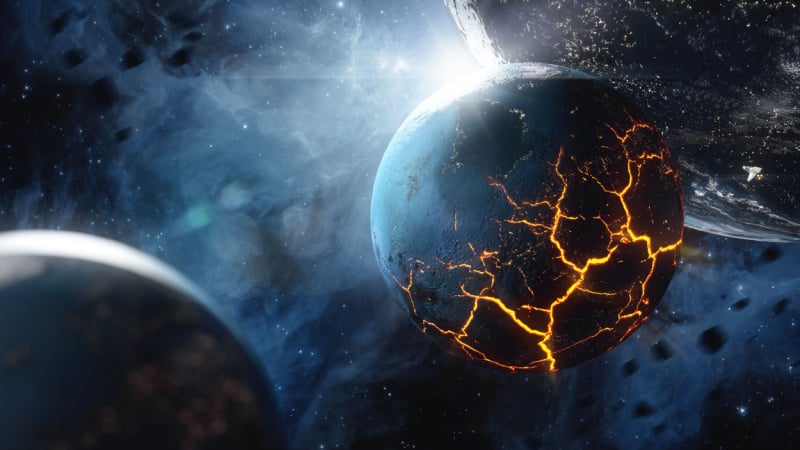Genshin Impact: What is Celestia?

Many players have noticed a floating island seen in the sky from Mondstadt and Liyue. It looks like someone grabbed a chunk of land and made it float in the sky. It’s Celestia, the so-called home of the gods in Teyvat.
Judging by the setting, it’s the location of the very first cutscene where the twin Travelers meet the Sustainer of Heavenly Principles. It’s also theorized to be Genshin Impact’s log-in screen, with all the pillars and the door. So much of it is still a mystery, but let’s go over what the game has revealed so far.
Table of Contents
What is Celestia
From the very beginning of the game, it seems to be where the twins planned to leave Teyvat. There were no buildings in the cutscene, just many, many pillars and crumbling bridges. Those are features similar to the log-in screen of the game.
When looking at it in-game, it’s an archipelago of islands around a large central one. That island seems to have a tall tower in the middle. The tower ist a large structure, as a dome can be seen peeking out of the bottom of the island. Some of the satellite islands look to have lush greenery and other structures.
Various in-game dialogue and lore tidbits say it’s the home of the gods with a higher position than the Archons. These gods were speculated to be the cause of the destruction of Khaenri’ah as well, through the Archons.
The people of Teyvat seem to believe that certain chosen mortals ascend to Celestia to become gods. So far, the only two characters described to have done so are Vennessa, the hero of Mondstadt, and Guhua, a figure believed to be an Adeptus. For people who read the comics, they’ve also seen Vennessa’s reaction to ascending, as well as a peek at the inside of what seems to be the central tower.
She didn’t seem to be too enthused about the whole thing. Dainsleif implies that ascended mortals do not become equal with the gods of Celestia when ascending. Also, the panel showing the interior of the tower depicts something like a panopticon. That’s a structure like a prison that allows a singular watch person to see and observe all the prisoners, all the time. Suffice it to say, it’s nowhere near anyone’s idea of what godhood ought to look like.
Celestia couldn’t be seen from the Golden Apple Archipelago during the Midsummer event, as well as from Inazuma. While the GAA could plausibly be uninhabited, the most probable reason it can’t be seen from Inazuma is that Raiden Ei cut off ties with it.
What We Know
Before floating somewhere to the northwest of Mondstadt and west of Liyue, Celestia could travel freely throughout Teyvat. For a time, it was anchored at the peak of Dragonspine by the Skyfrost Nail. The description of the boxes of the keys to the secret room on the mountain corroborates this. There’s also the mural in the final room of the mountain that explicitly depicts the situation.
More details can be found through the Blizzard Strayer artifact descriptions. A prosperous people once lived on the lush green mountain. They worshiped a white tree (presumed to be an Irminsul tree) on the mountain that flourished and grew as long as Celestia gave its blessings.
However, the floating island left suddenly, leaving the Skyfrost Nail to crash into the mountain. This caused a huge climate change in the mountain, turning it into a frozen wasteland. It also killed their white tree, leaving the civilization to perish in the ensuing eternal cold. A hero tried and failed to save them, coming back too late to change their fate.
A mural of Celestia may also be found on Tsurumi Island, floating near one of the peaks on the island. This suggests that it can once be seen from Inazuma, but not anymore. It’s unclear whether this mural was done before or during the island’s being covered in fog due to the Thunderbird’s power. Moreover, its proximity to various Ruin Guards in disrepair among the ruins speaks of some kind of conflict in those ruins.
The ancient civilization that made the drawing cannot be allied with Khaenri’ah, as the people of the latter do not believe or have gods they worship. Therefore, natives of that ruined kingdom cannot be the ones to make the mural (unless they were planning an assault). However, nothing in the art suggests that. Conflict is the only explanation which explains the presence of that ancient technology among depictions of the gods.
We’ll learn more as the game adds locations and breadcrumbs to this mystery.
Relationship With the Archons
Archons connect and communicate with Celestia through their Gnosis. Those are chess piece-shaped objects of power Archons usually keep on their person (with notable exceptions). The Anemo Archon held a queen piece, and the Geo Archon held a rook. The Electro Archon’s Gnosis was not shown in-game. It was not in the hands of the Archon at the time, and it was traded away before the Traveler could see it. Theorists say that it was either a knight or a bishop, though her Statue of the Seven implies the latter.
Venti suggests that ‘allogenes’ (those with Visions) have the potential to ascend to Celestia and become a god. Following the chess analogy, they are like pawns who can transform into a different piece once they fulfill a condition. In chess, that’s reaching the other end of the board. In Genshin, that condition is unrevealed.
The only depicted ascension is Vennessa’s, and she’s not seen to have a Vision on her person. It suggests that any mortal can ascend to Celestia with a sufficient enough feat of some kind. Vennessa earned her place when she defended her people and unintentionally instigated a revolution in Mondstadt. The huge oak tree in Windrise is where she ascended, making the tree a link to Celestia. Venti used that connection to heal himself after La Signora stole his Gnosis.
Not much is said about Guhua, only that he’s believed to be an Adeptus and he vanished into some purple haze in the Huaguang Stone Forest. If he really were an Adeptus, he would have a Vision. Otherwise, he might have not owned one as well.
Role in Granting Visions
At any rate, for some time players and speculators believed Archons were the ones distributing Visions. One of Ei’s voice lines proves that theory wrong. She expressed some curiosity about the fact that no new Electro Visions were granted during the time that she started the Vision Hunt Decree. Also, she states outright she has no power to decide who gets a Vision, that it depends on a person’s ambition and a vague other.
That other could be Celestia’s whims. By process of elimination, it’s the only explanation that fits. It’s the only other possible source of power that can grant Visions. Although Ei says she doesn’t have influence, Celestia likely uses the Archons as conduits to grant the Vision. Otherwise, what could be the reason why no new Electro Visions were granted during the Vision Hunt Decree?
The circumstances of people receiving their Visions also line up with the corresponding Archon’s ideal, for the most part. Some of them don’t quite seem to match or perhaps there are different rules for different races, such as the adepti. Xiao implies that they get their Vision differently, after all. Ganyu is half-adepti, so human ways could work, and she did get her Vision later in life.
Aside from that, it’s also possible to resonate with the ambition of a masterless Vision. That’s what happens to a Vision when its owner dies. Kazuha brought along his dead friend’s Vision, looking for someone who can awaken it. He wasn’t sure it was possible. Little did he know it had happened to two playable characters, Ningguang and Mona. Kazuha himself was able to awaken his friend’s Vision for a moment, but not completely as he already has his own.
What Celestia Represents In-Game
Some players have predicted that it’s the last stage of the game. The Sustainer of Heavenly Principles would be the Final Boss, and the Travelers would be free to travel through worlds again. Of course, it means that the player Traveler would choose to stay to have more adventures in Teyvat before leaving. Either that or the Traveler would be able to cross to other ‘bubble worlds’ that are in the same universe as Honkai Impact and the upcoming Star Rail.
Evidence of this is the chess motif, as the Traveler finishing their journey means that they can be ‘promoted’ by ascending to Celestia. There’s also an inscription on the base of the Venti’s huge statue in Mond. It says (in reversed Mond script), ‘the gateway of Celestia’, suggesting that Travelers will return to Mondstadt to reach those floating islands.
With the game being in its second year, it’s going to be a long time before we can get to that point. There are still four countries to explore, the mysteries of Khaenri’ah and the Abyss to solve, and more characters to pull. Not to mention the Tsaritsa’s mysterious plans to rebel against the gods of Celestia to contend with.
There are still many things to discover in Teyvat, so let’s enjoy all the adventures it offers so far!















